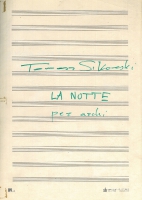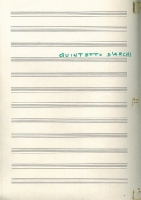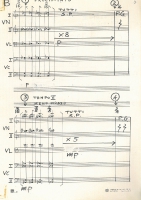La notte – Omaggio a Friedrich Nietzsche for string orchestra (1984)
In his very lyrical La Notte, like in other compositions from that period, Sikorski develops the expressive aspect of his music. The main focus of his experiments shifts to a search for varied harmonic hues, to an exploration of the relations between adjacent note combinations and changes in how a note combination or melodic motif is perceived, when it emerges in a new context.
The principle on which the structure of La Notte is based is similar to Sikorski’s other works written for string orchestra: Strings in the Earth and Winter Landscape. It involves juxtaposing expressively different fragments made up of contrasting musical material. The composer indicated parts or sections A, B and C, which differ in terms of their texture and expression. The outer parts (A and C) are based on the same lyrical and calm material (known from the Recitativo from the pieceRecitativo e Aria), though in part C it appears in a different ‘key’. Part B, on the other hand, consists of repeated short patterns of chords and rhythm built on three types of temporal values: short, medium and long. The patterns undergo harmonic, dynamic and agogic transformations.
Number 10 of this section is marked by an overlapping of two modules with different harmonies and tempos, which produces a phase shift effect. As the section progresses, the sound volume gradually increases and so does the tension, which reaches its climax in number 13, in broad, long chords.
A general pause is followed by a return of the lyrical material from part one leading to a surprising finale featuring a D major chord with a light colour and delicate sound. Next comes a strongly dissonant, dense chord, F-G flat (F sharp)-G sharp-A-C-C sharp-D-D sharp, brimming with minor seconds and destroying the quiet mood of the part. With its dark and mysterious expression it leaves the listener in suspension, feeling anxious, as if in connection with a seemingly simple, but very difficult to interpret quote from the Rigveda included in the score: ‘So many more dawns have not yet risen.’
La Notte closes a triptych of sorts dedicated to the string orchestra, which begins with Strings in the Earth (1979-80) and continues in Winter Landscape (1982) (Recitativo e Aria should be regarded as a ‘prototype’ of La Notte). Written at regular intervals, this mini-cycle shows the direction in which Tomasz Sikorski’s oeuvre could have gone and where it did not go – because of his sudden death, lack of confidence in his own work or great aversion to any manifestations of emotionality in music. As Szábolcs Esztényi recalls, when he asked Sikorski how he should interpret one of his piano works, the composer replied: ‘Just avoid sentimentalism, because I hate it!’
After a performance of La Notte Olgierd Pisarenko rightly noted:
It is amazing how Sikorski is able to produce a weighty, profound artistic statement out of a few musical morsels; Maksymiuk, like few other conductors, is able to discover the true value of these modest scores.






